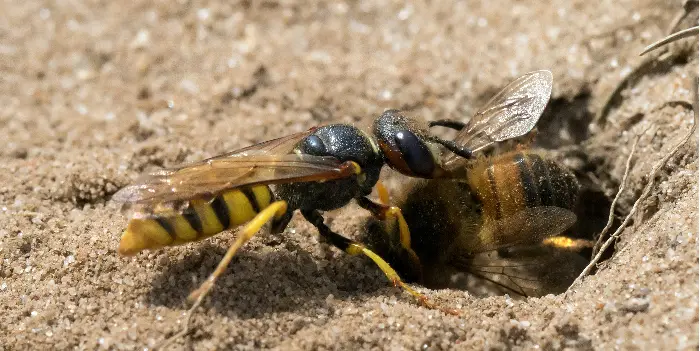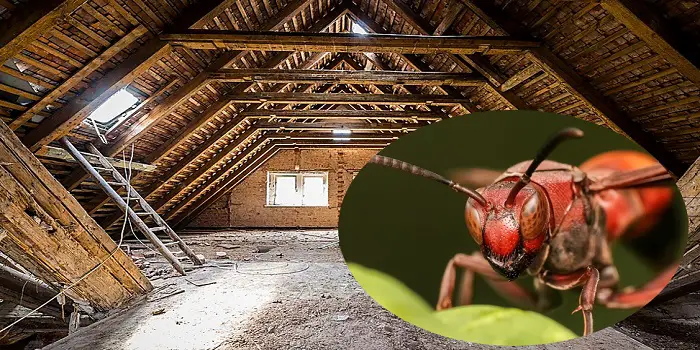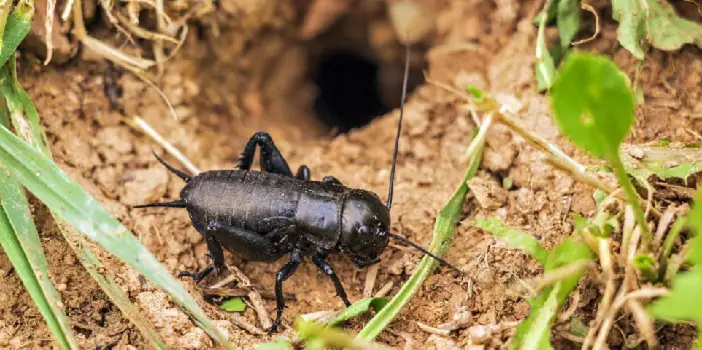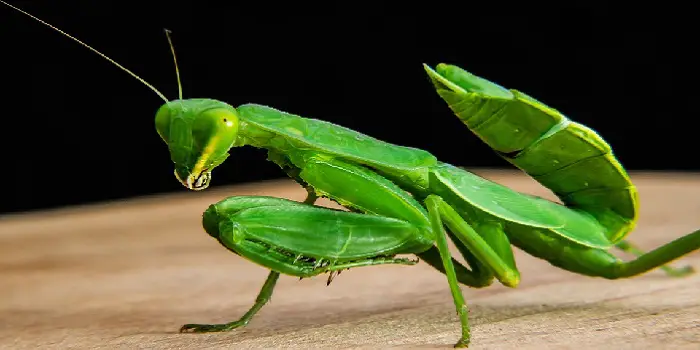
Termites have remained to be a tough pest to eradicate in our homes.
They occur naturally almost in all types of soil you build your houses on.
In the construction industry, for example, it has become a tradition to first apply ant termites on the foundation before you erect the superstructure work.
These are not specified for residential housing only but for all forms of houses where you use wood, sheetrock, and other items that termites may attack.
Preventing the termites from spreading at the initial stages of construction is the best option for treating termites.
This can be done by the use of anti-termites applications regularly to keep off the termites.
These treatments will, however, vary according to the level of termite infestation in your property or building.
Types of Termites
In order to get rid of these small insects, it is essential to know more about them and the steps you can take to stop them from damaging your wood.
Let’s start with the types of termites. These are mostly of two types:
1- Subterranean termites –
These types usually reside under the ground. These can be hard to eradicate since they are nowhere to be seen unless you dig.
They are however eradicated by the use of monitoring systems and baiting services by specialists.
2- Dry wood termites –
These types reside in wood materials. They can feed on the wood as well as infect the furniture and walls.
These are treated best by the use of wood treatment and fumigation. This can be at a particular area or the whole structure.
Are Termites Harmful to Humans?
Termites would be innocuous insects if they were not; for one thing, they love to eat wood.
This includes items made from wood such as furniture, support beams, and other areas of your home that are made from this natural product.
As far as humans are concerned, termites can sting and can even bite them.
Although termite-bitten wounds are not toxic, certain people may experience allergic reactions.
You would also be astounded to know that although termites don’t carry or transmit diseases to humans, they can trigger attacks like asthma and other respiratory disorders to humans if they reside for long in homes infested with termites.
Certain people (along with the kids and pets) may also be allergic to the saliva and droppings of termites.
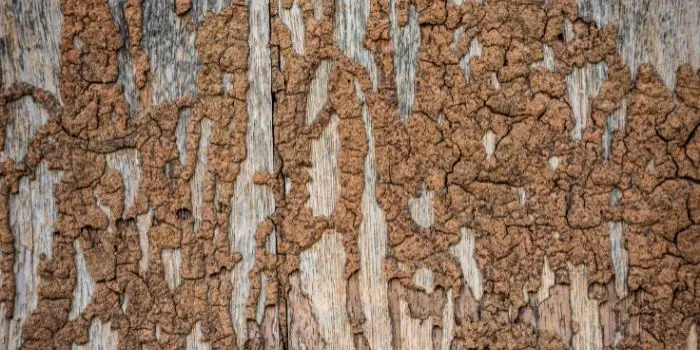
Signs of Infestation – How to Detect Them?
Careful interior and exterior inspections are necessary when you want to eradicate termites completely from your property.
If you leave some of them alive, chances are, they will repopulate the area making it hard to deal with them again.
A few structural damages that can be a possible sign of termite infestation are:
- Flying termite swarms
- Damaged or crumbling wood
- Micro holes in the drywall, discolored walls
- Drooping wooden floors and loosening tiles
- Squeaky floorboards, stuck doors, and windows
- Water-damaged ceilings and swollen wooden flooring
- Mud tubes on painted walls, inside cabinets, and furniture
- Hollow wood and pieces of dirt around baseboards, window sills, and door trims
- Loads of broken wings, dry wood termite feces that looks like mounds of pepper or salt
How to Detect Them?
A good way to detect these insects is by finding their discarded wings. These are mostly found on baseboards or window sills.
If you find some, it’s a sign that they’re done with mating and have discarded their wings close to your property.
Maze on the walls and wooden surfaces can also be found if the infestation has been there for a long and you haven’t noticed.
This may be detected as significant damage in your basement, attic, or tunnels burrowed in the yard.
Noise: Not all of you might know, but termites make a faint noise – you can hear it if you pay close attention to it.
If you think you have an affected wood or drywall, gently tap against or poke the surface with a screwdriver.
If you find the tip of the screwdriver going easily inside the hollow surface, it’s a common sign of infestation.
If not, this may just be starting, and you would be able to hear the noise of termites.
Termites usually make a noise like paper rustling when they are eating through the inside of the wood near to the surface.
When tapped gently, this type of surface makes a hollow sound.
Not all the termites, but the “soldiers” will also bang their heads into the wood (which sound like an alarm) if they detect something wrong.
Exterminators generally use a stethoscope to hear these types of sounds in your property to detect even the smallest infestation of hidden termites.
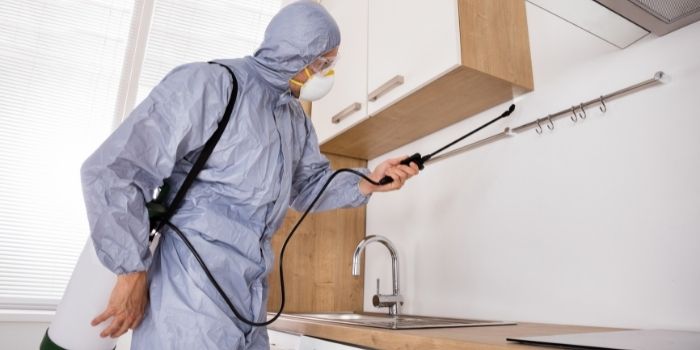
15 Methods You Can Use for Killing Termites
Every year, millions of dollars in property damage is caused by termite infestation.
It may seem like an impossible task, but there are natural methods to both remove termites and prevent them from coming into your home.
What follows are some simple humane tips you can employ to make your residence termite-free.
1- Bait & Trap
You can create a simple bait system by using cardboard.
Simply place pieces of cardboard that are small enough to fit into the most infested areas but large enough to trap plenty of termites.
Because the cardboard is readily available for cellulose food, the termites will tend to swarm to it.
This means that you can remove the cardboard along with most of the termites and dispose of it properly.
This is best used when you have other methods of termite control available, such as those that are listed in this article.
2- Salt and Warm Water
If you want to save money on termite extermination, salt may be your best choice.
A combination of salt and warm water will cause the termites to dehydrate and die over time.
Simply mix up a batch and then use a syringe to inject it into the areas of infestation.
You can use it both to react to termites in your home and as a preventative measure as well.
Salt will not work against large infestations, but smaller ones in the drywall or wood will be mostly destroyed when using this product.
3- Cayenne Pepper
Cayenne Pepper adds a kick to the meals that you eat but has a far more devastating effect on the termites.
The pepper will damage their nervous systems and cause them to die.
What makes cayenne pepper an excellent choice is that it is safe to use inside the home, inexpensive, and quite effective when you have a small termite invasion.
Just sprinkle the pepper around the places where termites have entered your home or on the nest.
Just be aware that there may be far more termites than what you see, which may mean that other methods must be used.
4- Diatomaceous Earth
This is a type of sand that is created from algae that have been fossilized.
It is harmless to humans and pets but deadly to termites as the small particles have razor-sharp edges.
They cut just deep enough into a termite to allow their moisture to escape, which causes them to die.
But the sharp edges are so small that they will not cut the skin of humans or pets. You can spread this substance wherever it is needed.
5- Nematodes
If the term nematodes are unfamiliar, then you may know them by their other name, roundworms.
These worms are so small that they are seemingly invisible. But they love to feast on termites.
They are also quite effective in killing termites without damaging the wood.
Plus, once they consume all the termites, they pass away.
Mix some nematodes with water and spray them into an area infested with termites.
Keep spraying once per day until they are gone.
6- Orange Oil
Coming from the rinds of oranges, this oil has just enough toxicity to kill termites, but does little harm to pets and humans.
Orange oil is best when used as a preventative measure against termites.
This means that you drill holes into likely places where termites might invade and then apply it.
The oil also works right at the beginning stages, but if the termites are well-emplaced, then you might want to try another method.
7- Neem Oil
Neem oil works indirectly by not allowing the termites to reproduce.
Extracted from the fruits and seeds of evergreen trees in India, this oil actually changes how the hormonal system of termites works.
They lose interest in eating food along with reproducing.
So, while neem oil will not kill the termites right away, you’ll notice a sharp drop-off in their population as the older ones start to die with no newer ones replacing them.
Take one liter of water and mix two ml of liquid soap and 5 ml of neem oil.
Pour into a spray bottle and apply it where you see the termites. It only lasts about eight hours, so you will need to reapply each day until the termites are gone.
8- Lemon & White Vinegar
This simple combination can kill termites fairly quickly and is one of the best organic ways to kill termites.
Mix the juice of two lemons with a half-cup of white vinegar, put it in a spray bottle, and apply it to the affected areas of your home.
Ideally, you’ll want to spray this into the nests which will destroy the termites fairly quickly.
Another option is to spray it on wooden areas that are vulnerable to termite infestation.
Repeat until you see no more signs of termites. It is safe to use once each day and offers a simple, inexpensive means of killing termites.
9- Sunlight
Using sunlight to your advantage for free is one of the best home remedies for getting naturally rid of termites.
Since termites like to habitat in darkness, the natural light and heat of the sun will help to kill these insects fast.
However, you can use this method only when removing the affected item and exposing it to sunlight.
You just need to take the item (like the furniture) outside on a sunny day. Place it securely and leave it there for 2-3 days or more, depending on the infestation.
10- Microwaves
Just like natural sunlight, using microwaves can also help in getting rid of these small insects effectively.
Depending on the portable device you use, treatment time, and a few other factors, this method can offer about 90% of success.
You should be placing a wooden board of 1 to 2 feet for about 20 to 30 minutes in the microwaves without drilling any holes in the wood.
Depending on your location, the availability and the cost of this method may vary.
11- Electrocution
Electrocute, or electrocution, is a process of killing or injuring someone using electric shock.
Fortunately, the method can now be used for killing termite insects.
You would need to use portable electrocute electric devices for this purpose.
Although drilling the holes in the affected wood item isn’t necessary if you can do it the process can be fast and more effective.
12- Aloe Vera Plant
IMO, the home remedy of using aloe vera spray can help to kill the termites and bugs naturally very fast.
To prepare the spray, crush the plant and add it with water in a container.
After a few hours, strain the liquid in a mist sprayer. Add five parts of water to 1 part of this aloe liquid.
The spray is now ready to be directly sprayed on the insects.
13- Essential oils
Essential oils like clove bud oil and vetiver oil are very effective in killing termites.
Like you did with aloe, you can prepare the spray in a mist sprayer using water and some oil.
Then spray it directly on the affected area where you think these creepy crawlies are nesting.
14- Sodium chloride
Sodium chloride is an organic compound that can kill and prevent the reinfestation of termites.
Take several cotton balls and soak them in the compound with some cleaning agent.
Fill all these sodium chloride-soaked cotton balls in a plastic bag. Place it in and around the infested areas.
15- Boric Acid
Despite its name, boric acid does not cause damage to the wood.
Instead, termites ingest the boric acid, which does not allow them to obtain nutrients.
The result is that the termites actually die of starvation even when surrounded by wood.
You can either use the acid in its powdered form or dilute it with water to spray around areas that have been infested with termites.
Precaution and Tips
No matter what method you choose to stop the infestation, you must check the infested areas periodically (preferably once a month).
Repeat the elimination process if you find any kind of re-infestation.
When using the chemicals, be sure to wear the proper protection, which includes a mask, goggles, and gloves to protect yourself from the acid.
You may need to reapply the acid from time to time in vulnerable areas of your home.
It is better to use it outside than inside, so keep that in mind.
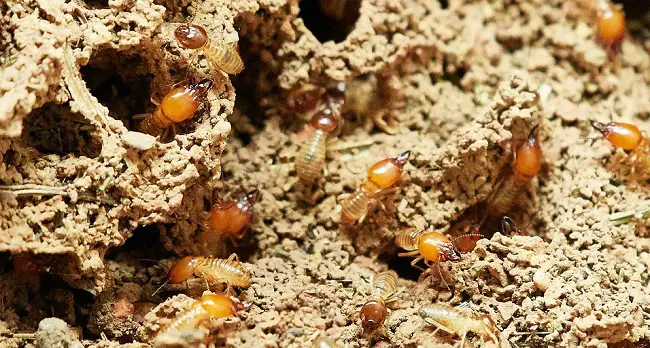
Difference Between Termites and Flying Ants
Often confused with one another, flying ants and winged termites may sometimes resemble but are not the same – they are very different.
Determining whether you have one or the other is important so that you know how you should specifically treat the problem.
| Termites vs. Ants | Winged Termites | Winged Ants |
|---|---|---|
| Wings | Large – about twice their body | Short |
| Wings | Uniform in size | Larger front wings than in the back |
| Antennae | Straight | Elbowed |
| Waist | Broad waist | Thin waist |
| Body Structure | Uniform width along the entire body | Appear to be segmented |
| Eyes | No visible eyes | Eyes are present and visible |
Where Do Termites Live and What Do They Eat?
Termites can silently attack and live on a variety of materials in your home, basement, attic, crawlspaces, a garden fence, or any other part, particularly where the wood is present.
Leaky pipes, clogged gutters, under the sink, in the laundry room, or other parts of your home that has standing water (like near the pond or pool) can also be an attractive spot for these insects to build their nests.
These are the places where they get the needed moisture, ideal temperature, food, and shelter to survive.
When it comes to termites’ favorite meal, they can feed on various items, typically those from where they can get the cellulose.
Cellulose is an organic compound found in nature (such as in plants or plant by-products) and in other household materials that humans use in their day-to-day life.
Few household items that termites may feed on include wood, paper products, cotton fibers, clothes, sheetrock, particleboard, etc.
In the wild, termites are in regular search of dead and decaying cellulose.
So, they will most likely eat live trees and dry wood like cypress, redwood, or poplar.
Some of them may also feed on the bones of long-buried dead people.
They may find it tough to eat through items like concrete, bamboo, painted wood, oriented strand board, plastic materials, pressure-treated lumber/plywood, etc.
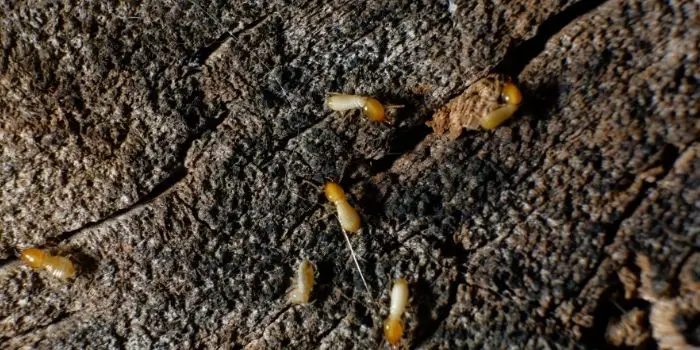
Commercial Wood Treatment Products for Termites
In addition to natural home remedies, there are several commercial products that are now available to buy online to get rid of these cellulose-eating bugs.
Some of them you can try to protect your wood and drywall are:
1- Bora-Care
Products like these contain borate (or borate salt), which is an effective insecticide.
Bora-Care is a less toxic product that can be used as a wood preservative. Its safe for humans and pets but can be hazardous for insects.
You can use it on the affected damp wood or on tunnels in sheetrock where you see the bits of dirt, mud tubes, or fecal pellets.
2- Termidor SC
It’s a type of suspended concentrate that not only helps in eliminating the flying termites but also keeps them off from future infestations.
This effective termite killer is available in the form of a liquid bottle or as a foam spray.
Remember, it’s a product for outdoor use, and you should use it safely as directed by the manufacturer.
3- Termite Bombs
Termite bombs (also called bug bombs or pesticide foggers) are easily available online at hardware stores near you.
These consist of a liquid insecticide (termiticide) usually packed in the form of pressurized aerosol cans.
When used on the affected surfaces, these bombs can kill the insects soon.
Care has to be taken while using these termiticide bombs, as ingesting or inhaling them can be harmful.
4- Anti-Termite Paint
Termites won’t enter or eat through painted wood surfaces.
Painting the old wood is, therefore, another good way to protect the wooden surface from these insects.
Make sure you prepare the wood properly with a good primer, and then apply the best termite-proof paint that comes with a high-quality termite paint additive.
5- TERRO Aerosol Spray
Terro is a more qualified item if you want to control flying termites and other insects like carpenter ants for up to weeks.
The sprayer is easy to use and can be sprayed easily into small cracks and crevices.
You can use it indoors as well as outdoors. Make sure you repeat the spray after a few weeks to prevent the insects from coming.
6- Bayer Diy Termite Killer
This is a granule-based wood termite killer that comes at a reasonable cost at sites like Amazon.
You need to place them around the wooden structures or can pour them directly on the dirt seen in the yard.
It works to treat the area without any repulsing or slaughtering.
7- Spectracide Terminate Killing Stakes
This is an impressive advanced way of controlling the insects and damage caused.
It’s more suitable for outdoors, like in a garden where you will need to place the stakes in the ground for it to work.
This will check for termite activity inside the ground and will kill them.
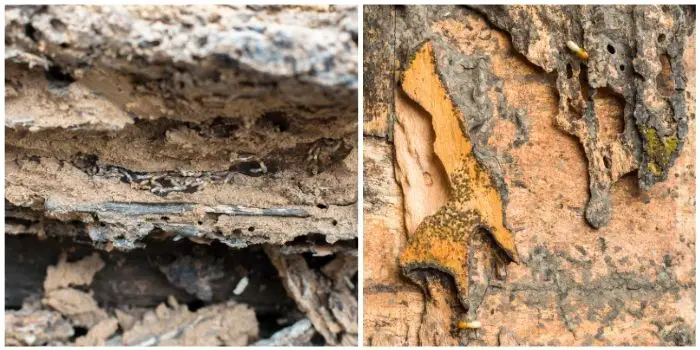
Termite Inspection, Control, and Cost of Pro Treatment
Termites control is a field that has brought up a lot of concern due to the difficulty in fighting termites.
Specialists need to be involved whenever you intend to control the termites because it is very hard for you to be successful on your own.
The specialists are, however, trained to get rid of the winged termites the first time they are involved.
Before the actual treatment, it is advisable to conduct an inspection program.
This can necessitate the involvement of a pest control specialist to do the process precisely and thoroughly.
This step ensures that the house is properly scanned for all types of pests. It also helps to determine the most effective method to treat termites.
After the complete inspection, the specialists will come out with a report and evidence that will help determine if further control measures are required or not.
If one is required, the same specialists can do the job for you at affordable prices.
They are best suitable for that because they already know the problem sources and the best ways to treat them.
Remember that the costs of dry wood termite inspection are not fixed for all the termite problems.
They vary with the different companies and specialists involved.
These services are however generally not expensive but manageable to many considering the damage extent that they prevent.
The Conclusion
Termite control and prevention have become a trend in the pest control field.
It is becoming more and more difficult to fight the already present termites. And if treated, they still have done some damage to the property.
A persistent termite issue might therefore need professional assistance to rid them from your home.
This is especially true when you cannot locate the nest or suspect that termites may be damaging your home in places that you cannot reach.
You can obviously try the above organic methods to control termites, but the termite inspection from a professional pest control expert can identify and rid your home of termites when natural methods fall short.
Share the post "15 Best Ways to Kill Termites Naturally – In Drywall or Wood"

Welcome to ProShieldPest.com. I am Tina Jones. I have been working as a pest removal professional in Winslow, Arizona lately. At present, I love to spend my time with my family as a retiree.
Here I share all my knowledge and experiences to help people understand better how they can stop pests at their homes without actually killing them. Hopefully, the information you will find here will help in safeguarding your home! You can check more about me here.

